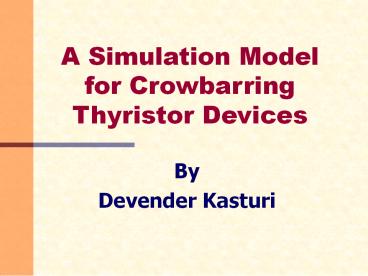A Simulation Model for Crowbarring Thyristor Devices - PowerPoint PPT Presentation
Title:
A Simulation Model for Crowbarring Thyristor Devices
Description:
A Simulation Model for Crowbarring Thyristor Devices By Devender Kasturi – PowerPoint PPT presentation
Number of Views:181
Avg rating:3.0/5.0
Title: A Simulation Model for Crowbarring Thyristor Devices
1
A Simulation Model for Crowbarring Thyristor
Devices
- By
- Devender Kasturi
2
Advisory Committee
- Major Advisor
- Dr. Albert B. Grubbs.
- Committee Members
- Dr. Vijay Vaidyanathan
- Dr. Monty Smith
- Industrial Representative
- Mr. Phillip Havens
3
Overview
- Introduction
- Definition of terms
- Background of the Problem
- Problem Statement
- Purpose of the study
- Methodology
- Review of Literature
4
Overview
- Research Questions
- Assumptions
- Limitations
- Hypothesis
- Expected Outcomes
- Significance of the study
- Time Line
- Questions and Suggestions
5
Introduction
- Causes for damage of Electronic equipment
- Wear and tear
- Overvoltage
- Overcurrent
6
Overvoltage Overcurrents
- Lightning
- Power line cross
- Conductive spikes
- Inductive spikes
7
Definition of Terms
- VDRM Peak Standoff voltage across the device in
the off condition. - IDRM Maximum value of leakage current at VDRM.
- VT Voltage across the device after it has
turned on.
8
Definition of Terms
- VS Maximum voltage across the SIDACtor device
just before switching on. - IH Minimum amount of current required to
maintain the device in the on state. - Surge waveform(ex 10x700?sec)
9
VI characteristics of SIDACtor device
10
Background of the Problem
- The SIDACtor device
- Characteristics of actual model
- Existing SPICE model
- Comparison of actual device and existing PSpice
model for a 10x700us surge.
11
Actual Device (P3100) Characteristics
12
Existing PSpice Model (P3100)
13
Actual device Vs Existing model
- Overshoot of PSpice model is more than 3 times
than that of actual devices. - VT is very high for the PSpice model.
14
Statement of Need
- There is a need for a new PSPICE model of the
SIDACtor device.
15
Problem Statement
- The problem is the characteristics of the actual
device and that of the existing simulation model
do not match.
16
Purpose of the Study
- To develop a PSpice model by modifying the
existing PSpice model or - To develop a new PSpice model.
- Test the newly developed model for various surge
waveforms.
17
Research Questions
- Will the new simulation model have the same
characteristics as that of actual device? - How reliable is the PSpice simulation software?
- What is the range of operating temperature for
the device?
18
Methodology
- Experimental
- First the existing model is built and tested.
- Research will be done and the changes that have
to be done are identified.
19
Methodology
- Model is changed and tested for various surge
events. - Repeat steps 2 and 3 until the simulation model
characteristics are within 10 of that of actual
device.
20
Review of Literature
- Circuit simulators employ Newtons method to
solve the nonlinear systems of equations that are
formed during DC and transient analysis. - Convergence problems can occur due to poor
starting points defined for the simulation.
21
Review of Literature
- Errors in specifying circuit connectivity,
component values, or model parameter values often
cause convergence problems.
22
Review of Literature
- SIDACtors working is similar to that of a
thyristor except - No gate current can be applied to the SIDACtor
- SIDACtor is bidirectional
23
Assumptions
- Actual device works properly
- Test equipment works properly
24
Equation for Current through the thyristor
- Where Ico1 and Ico2 are leakage currents from
collector to base and ?1 and ?2 current
amplification factors
25
Limitations
- Resources
- PSPICE software
- Test Equipment
26
Hypothesis
- Null Hypothesis
- The characteristics of the newly developed
PSpice model and that of actual device differ by
more than 10.
27
Hypothesis
- Alternative Hypothesis
- The characteristics of the newly developed
PSpice model and that of actual device differ by
no more than 10.
28
Expected Outcomes
- The newly developed PSpice model will exhibit a
lower overshoot. - The newly developed PSpice model will exhibit a
lower VT value. - The newly developed PSpice model successfully
clears all the tests.
29
Significance of the Study
- The simulation model is used for tests rather
than the actual device allowing any modifications
under considerations to be tested. - Eventually expedites prototype testing.
30
Timeline
- April 2003 Review of Literature and current
model. - Summer 2003 Experimental Analysis and Report
Writing - Fall 2003 Final Report
31
Questions Suggestions































